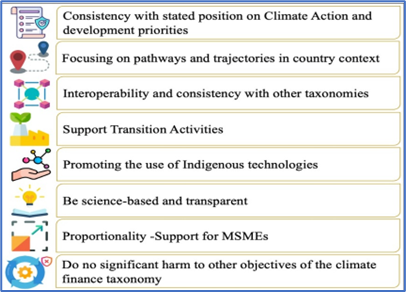Why in News?
The Finance Ministry has released a draft document titled ‘Framework of India’s Climate Finance Taxonomy’ aimed at guiding investments towards clean energy and climate-resilient infrastructure.
The taxonomy is intended to provide clear definitions and criteria for identifying environmentally sustainable projects.
What’s in Today’s Article?
- India’s Draft Climate Finance Taxonomy Framework
- India’s Climate Adaptation and Energy Investment Targets
India’s Draft Climate Finance Taxonomy Framework
- The Finance Ministry has released a draft ‘Framework of India’s Climate Finance Taxonomy’ to guide investments into clean energy and climate-resilient infrastructure.
- It aims to:
- Classify economic activities as sustainable or transitional.
- Encourage climate-friendly technologies.
- Prevent greenwashing.
- Greenwashing refers to the deceptive practice of making unverified or exaggerated claims about environmental or climate-friendly actions.
- It misrepresents actual progress on climate change, encouraging irresponsible actions while falsely rewarding entities for their "environmental efforts."
- Align with India’s twin goals: Net Zero by 2070 and Viksit Bharat by 2047.
- Principles of the Climate Finance Taxonomy
- Purpose and Global Relevance
- It acts as a tool for investors and banks to identify credible green investments.
- Supports India’s stance in global climate negotiations by setting a national standard for defining ‘climate finance.’
- Responds to international disputes where developed countries often overstate contributions to developing nations.
- Categories of Climate Activities
- Climate Supportive: Activities that directly reduce greenhouse gas emissions or improve climate resilience.
- Climate Transition: Activities that help reduce emissions intensity in hard-to-abate sectors like iron, steel, and cement.
- Key Sectors Covered
- Power generation
- Buildings and infrastructure
- Mobility/transport
- Agriculture and food systems
- Water security and resource management
India’s Climate Adaptation and Energy Investment Targets
- Massive Scale-Up in Power Generation Capacity
- Target Capacity: Increase installed power capacity from 470.4 GW (Feb 2025) to 777.14 GW by 2029–2049.
- Technology Focus: Prioritize investment in Advanced Ultra Super Critical (AUSC) thermal power plants.
- AUSC plants offer 46% efficiency, compared to:
- Subcritical: ~38%
- Supercritical: ~41–42%
- Goal: Achieve higher efficiency and lower emissions in thermal energy generation.
- Climate Adaptation Investment Requirement
- Total Investment Needed: Based on India’s Initial Adaptation Communication to the UN (December 2023), India needs ₹56.68 trillion (≈ USD 648.5 billion) by 2030 (based on 2023–24 prices).
- Sectors Covered:
- Agriculture
- Forestry
- Fisheries
- Infrastructure
- Water resources
- Ecosystems
- Purpose: Fund adaptation actions to minimize adverse impacts of climate change.










